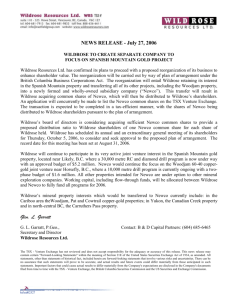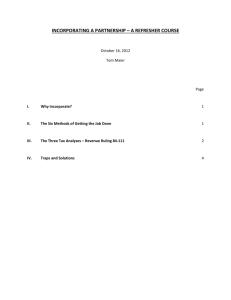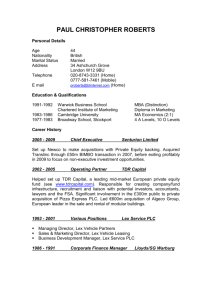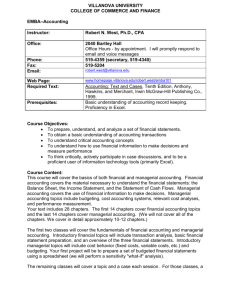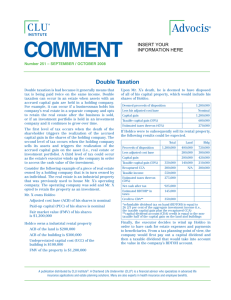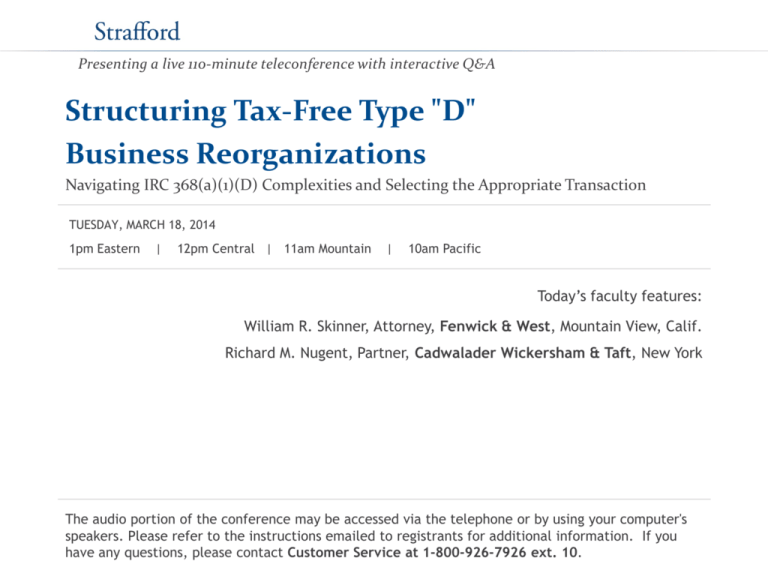
Presenting a live 110-minute teleconference with interactive Q&A
Structuring Tax-Free Type "D"
Business Reorganizations
Navigating IRC 368(a)(1)(D) Complexities and Selecting the Appropriate Transaction
TUESDAY, MARCH 18, 2014
1pm Eastern
|
12pm Central | 11am Mountain
|
10am Pacific
Today’s faculty features:
William R. Skinner, Attorney, Fenwick & West, Mountain View, Calif.
Richard M. Nugent, Partner, Cadwalader Wickersham & Taft, New York
The audio portion of the conference may be accessed via the telephone or by using your computer's
speakers. Please refer to the instructions emailed to registrants for additional information. If you
have any questions, please contact Customer Service at 1-800-926-7926 ext. 10.
Tips for Optimal Quality
FOR LIVE EVENT ONLY
Sound Quality
If you are listening via your computer speakers, please note that the quality
of your sound will vary depending on the speed and quality of your internet
connection.
If the sound quality is not satisfactory, you may listen via the phone: dial
1-866-873-1442 and enter your PIN when prompted. Otherwise, please
send us a chat or e-mail sound@straffordpub.com immediately so we can address
the problem.
If you dialed in and have any difficulties during the call, press *0 for assistance.
Viewing Quality
To maximize your screen, press the F11 key on your keyboard. To exit full screen,
press the F11 key again.
Continuing Education Credits
FOR LIVE EVENT ONLY
For CLE credits, please let us know how many people are listening online by
completing each of the following steps:
•
Close the notification box
•
In the chat box, type (1) your company name and (2) the number of
attendees at your location
•
Click the SEND button beside the box
For CPE credits, attendees must listen throughout the program, including the Q &
A session, and record verification codes in the corresponding spaces found on the
CPE form, in order to qualify for full continuing education credits. Strafford is
required to monitor attendance.
If you have not printed out the “CPE Form,” please print it now (see “Handouts”
tab in “Conference Materials” box on left-hand side of your computer screen).
Please refer to the instructions emailed to registrants for additional information.
If you have any questions, please contact Customer Service at 1-800-926-7926
ext. 10.
Program Materials
FOR LIVE EVENT ONLY
If you have not printed the conference materials for this program, please
complete the following steps:
•
Click on the ^ symbol next to “Conference Materials” in the middle of the lefthand column on your screen.
•
Click on the tab labeled “Handouts” that appears, and there you will see a
PDF of the slides for today's program.
•
Double click on the PDF and a separate page will open.
•
Print the slides by clicking on the printer icon.
Tax-Free Acquisitive D
Reorganziations
Strafford CLE Webinar
March 18, 2014
William R. Skinner, Esq.
wrskinner@fenwick.com
Fenwick & West LLP
Silicon Valley Center
801 California Street
Mountain View, CA 94041
Phone: 650.988.8500
www.fenwick.com
© Fenwick & West LLP, 2012. All rights reserved.
Overview
Statutory Requirements for the Two Types of D
Reorganizations
All Cash Acquisitive D Reorganizations
Tax Consequences to the Parties to the D Reorganization
Characterization Issues
6
The Type D Reorganization – Statutory Requirements
Sec. 368(a)(1)(D) defines a D reorganization as involving the
following elements:
Transfer of “all or part” of transferor’s assets to a
corporation
Transferor and/or its shareholders “control” the corporation
immediately after the transfer
Transferor distributes the stock or securities received as
part of plan of reorganization in a distribution qualifying
under § 354, § 355 or § 356
7
The Type D Reorganization – Two Paradigms
Acquisitive D
Divisive D
Shareholders
2
§ 355
Distribution
P
P
Liquidation
of S1
S1
1
S
2
1
S2
“Substantially
All” S1’s
Assets
Assets
8
The Type D Reorganization – Two Paradigms
Divisive D reorganizations.
Acquiring’s stock must be distributed in a spin-off that
qualifies under § 355.
“Control” test looks to § 368(c) definition.
Acquisitive D Reorganizations.
Acquiring must acquire “substantially all” of the assets of
Transferor. § 354(b)(1)(A).
Definition of “control” looks to § 304(c):
• Control = 50% vote or value
• Control may be direct or indirect.
• § 318 constructive ownership rules also apply.
9
Acquisitive D ReorganizationsLiquidation – Reincorporation Doctrine
A
2
§ 331
Liquidation
1
$700 Cash
S
T
$300 Cash
$700 Business Assets
Sell T
Business
Assets
Under pre-1986 law, the shareholder sought to receive T’s cash
in a tax-favored capital gain transaction.
D reorganization treatment resulted in A being taxable at
ordinary rates on the “boot dividend” (see § 356(a)(2)).
10
Special Rules for Acquisitive Ds
Non-Statutory Reorganization Requirements.
Continuity of interest test appears not to apply to Acquisitive
D reorganizations. See Prop. Reg. § 1.368-1(b)(1); Reg.
§1.368-2(l).
Continuity of business enterprise does apply, but usually is
met by virtue of T transferring substantially all of its assets
to A.
A non-tax corporate business purpose is also required.
Reg. § 1.368-2(l) permits “all cash” D reorganizations to satisfy
§ 368(a)(1)(D) so long as A and T’s shareholders own the two
companies in identical proportions.
T is deemed to receive a “nominal share” of A stock in order
to satisfy the “distribution requirement.”
11
Cash D Reorganization
Reg. § 1.368-2(l)(3), Example 3
P
“Nominal Share”
3
Distribution of
“Nominal” S4
Share
“Nominal Share”
S1
S2
S3
S4
2
1
T Liquidates
T
FMV $70
Conclusion: T undergoes a § 368(a)(1)(D) reorganization into
S4.
12
Integrated Transaction Doctrine
P
T
Transfer T
Shares to S
for $
S
T
2
T LLC
Convert T
to an LLC
Under integrated transaction doctrine, two steps (Drop and
Check) are treated as a D reorganization of T into S. See Rev.
Rul. 2004-83.
13
Tax Consequences of Acquisitive D Reorganizations
Generally, no gain or loss is recognized to the transferor
corporation. See § 361(b)(1)(A). Acquiring corporation
succeeds to Transferor’s tax attributes under § 381(a).
Shareholder recognizes gain, but not loss, to the extent that (A)
money and other property exceeds (B) gain on the exchange.
§ 356(a)(1) (the “Boot-within-Gain Limitation”).
If the gain has the effect of a dividend, the shareholder shall
recognize a dividend to the extent of its ratable share of the
undistributed earnings of “the corporation.” See § 356(a)(2).
Compare results of a § 304 transaction.
14
Example of Boot Treatment
D
$100 Cash
Basis $100
FMV $100
F2
F1
D Reorganization
$20 E&P
$500 E&P
$10 Foreign
Taxes (33% rate)
$55 Foreign
Taxes (10% rate)
Under § 356(a)(2), D’s gain / deemed dividend is limited to its
gain realized on the exchange of F1’s stock for cash (here $0).
What would be the results if D’s basis in F1’s stock was only
$50?
15
Cash D Reorganization vs. Section 304 Transaction
Comparison Point
Cash D
§ 304
Basis Recovery
Recognize gain to the
extent of cash, and
then recover basis
Recognize dividend to
the extent of E&P, then
recover basis before
recognizing gain.
Source of Dividend
Unclear (Target only
vs. Target and
Acquiring Combined)
Both Companies’ E&P
Combined
Whose E&P First?
Unclear
Acquiring First, then
Target
Section 367(a)
Consequences
None.
US Transferor must
enter Gain-Recognition
Agreement (GRA).
See Notice 2012-15.
Tax Attributes
T’s attributes carryover
to A under § 381
No carryover of
attributes.
16
Rev. Rul. 70-240
2
B
X Liquidates
Gain $30
X
E&P $10
1
Y
Sale of Operating
Assets
E&P $50
B recognized a $30 deemed dividend (out of X and Y’s
combined E&P). See also CCA 201032035.
Compare case law - e.g., American Manufacturing, 55 T.C. 204
(1970) (§ 356(a)(2) looks to Target’s E&P only).
17
Gain Recognition Agreement Consequences
D
1
F1
Transfer F1’s
Stock to F2
F2
2
F1 checks
the box to
liquidate
F1
Result: No gain recognition agreement (GRA) under § 367(a)
is required to be filed on the D reorganization of F1 into F2.
Reg. § 1.367(a), Example 16.
18
Basis Recovery and the Nominal Share
In D reorganization, basis is recovered against boot under
normal § 356 rules (pro rata unless terms specify that particular
shares are exchanged for cash).
Loss cannot be recognized. See § 356(c).
If there is unrecovered basis, it attaches to the nominal share
deemed issued in the reorganization.
Reg. § 1.368-2(l)(2) provides for deemed transfers that may
eliminate basis in the “nominal share.”
The shareholder may designate a share of stock in Acquiring to
which any basis in the nominal share attaches. See Reg. § 1.3581T(a)(2)( iii).
19
Example of Basis Allocation
D
$100 Cash
Basis $130
FMV $100
F2
F1
D Reorganization
D receives $100 of cash (as recovery of basis) and a nominal
F2 share with $30 of basis.
D can designate an F2 share to receive $30 of basis.
20
A More Complex Nominal Share Example
P
3
FS Distributes
“Nominal Share”
P Contributes
“Nominal Share”
FP
FS
2
4
Basis $130
FMV $100
FT Liquidates
1
FT
Sale of Assets
for $100
FA
FS receives $100 of cash and a nominal share of FA with $30
of basis. FS is deemed to distribute the nominal share under
§311(b). P is then deemed to transfer the nominal share to FP
in a § 351 transaction.
21
Slide Intentionally Left Blank
Consolidated Return Treatment
The foregoing treatment does not apply to D reorganizations
with boot inside of a consolidated group.
Rather, Reg. § 1.1502-13(f)(3) treats the shareholder member
as if it received hypothetical stock in Acquiring, followed by a
§302(d) redemption of the hypothetical stock.
This deemed dividend will generally be excluded from
income under Reg. § 1.1502-13(f)(2).
However, negative investment adjustments may cause the
nominal share to have an Excess Loss Account (ELA) that
is triggered on the subsequent transfers.
23
Reg. § 1.1502-13(f)(7), Example 4 – Part 1
P
B
M
2
1
S Liquidates
$100
Basis $25
Value $100
Assets
S
Facts: All Entities are domestic corporations. S undergoes a
cash D reorganization into B.
24
Reg. § 1.1502-13(f)(7), Example 4 – Part 2
2
Distribution of
Nominal Share
M
P
Nominal Share
B
Hypothetical
Shares
1
$100 302(d) Redemption of
Hypothetical Shares
Analysis. § 302(d) redemption creates a $75 excess loss
account (ELA) in nominal share of B stock. Following S’s
liquidation, M distributes the nominal share to P.
Distribution of nominal share gives rise to $75 gain under
§311(b) that is deferred under § 1.1502-13.
25
Selected Characterization Issues
Liquidation-reincorporation vs. Upstream merger and
asset drop
D reorganization with Boot vs. F reorganization and
Separate § 301 dividend.
Rev. Rul. 78-130 and drop-and-check transactions.
26
Liquidation – Reincorporation
Assume the sequencing of Rev. Rul. 2004-83 is reversed – i.e.,
Parent converts Target to a disregarded entity, and then
transfers Target DRE to Acquiring Corporation.
Is the form respected (upstream merger followed by § 351
transfer) or is this recast as a sideways D reorganization of
Target into Acquiring?
Reg. § 1.368-2(k) – a merger followed by an asset transfer
within the “qualified group” is not to be “disqualified or recharacterized” as a result of certain stock or asset transfers.
The qualified group is defined by Reg. § 1.368-1(d)(4) as the
Issuing corporation and all corporations owned by issuing
through one or more chains of § 368(c) control.
27
Example
P
1 Convert S 1 to
2 Assets Group A Extracted from
S1 to P
3 S1 LLC Contributed
LLC / DRE
to S2
S2
S1
Assets
A
Assets
B
See PLRs 201201012, 201127004 and 200952032 (form is
respected under Reg. § 1.368-2(k)).
Would result be the same if substantially all of S1’s assets were
28
reincorporated into S2?
PLR 201037026
Parent
S7
S6
1 Liquidate S 40
S13
S 40
NewCo
IRS characterized transaction as cash D reorganization of S40
into NewCo. Note S40’s assets left the “qualified group.”
29
D Reorganization vs. F Reorganization
Under IRS ruling practice, F reorganization treatment trumps D
reorganization treatment. See Rev. Rul. 87-27; Rev. Rul. 57276.
This characterization may be significant through:
Determining whether cash distributions are boot taxable
under § 356 vs. separate § 301 distributions
Determining manner in which Target’s E&P carries over to
Successor. See Reg. § 1.367(b)-9.
30
PLR 201001002
4
USP
Transfer Property
into NewCo
3
Distribute
cash/
property
NewCo
1 Transfer F7
2
F7
Liquidate F7
F7
Holding: Transaction was an F reorganization of F7 into
NewCo, with cash distributed in a § 301 distribution. The later
§ 351 transfer was respected as a separate step. See also
PLR 201406005.
31
Rev. Rul. 78-130
USP
Foreign
OpCo
§ 351Transfer
Foreign
OpCo
Foreign
HoldCo
Transfer Assets
and Liquidate
Transfer of
Other Assets
NewCo
IRS treated transaction as a Triangular C of Foreign OpCo into
NewCo instead of a § 351 transfer followed by a D
reorganization. Query whether this ruling remains valid. Cf.
PLR 201150021.
32
CIRCULAR 230 DISCLOSURE
To ensure compliance with requirements imposed by the
IRS, we inform you that any U.S. federal tax advice in this
communication is not intended or written by Fenwick &
West LLP to be used, and cannot be used, for the purpose
of (i) avoiding penalties under the Internal Revenue Code
or (ii) promoting, marketing, or recommending to another
party any transaction or matter addressed herein.
33
Divisive “D” Reorganizations
Richard M. Nugent
Cadwalader, Wickersham & Taft LLP
March 18, 2014
richard.nugent@cwt.com
Topics
Page
Introduction
2
IRS Private Letter Rulings
8
General Section 355 Requirements for Tax-Free Distributions
10
Section 355(e) Anti-Morris Trust Rules
19
Monetization Strategies for Section 355 Transactions
24
Sample Market Transactions
38
35
Introduction
*Portions of these slides were drawn from slides I previously prepared with my partner, Linda Z. Swartz. Any errors are mine alone.
36
What is a Divisive D Reorganization?
BEFORE
AFTER
Shareholders
Shareholders
Parent
Business A
Business B
Parent
Newco
Business A
Business B
• Unless otherwise noted, Parent and Newco are U.S. corporations, and Parent conducts at least 2
independent businesses and contributes 1 to Newco in the restructuring.
37
Divisive Section 368(a)(1)(D) Requirements
●
A D reorganization includes a corporation’s transfer of all or part of its assets
to another corporation if, immediately after the transfer, the transferor
corporation or 1 or more of its shareholders controls the transferee corporation
within the meaning of section 368(c), and the transferor distributes the
transferee’s stock in a transaction qualifying under section 355.
●
Section 368(c) requires ownership of at least 80% of a corporation’s total
voting power and 80% of the shares of each class of the corporation’s
nonvoting stock (“80 Control”).
●
Obama Administration proposal would require ownership of at least 80%
of a corporation’s stock by voting power AND value.
38
Section 368 Divisive D Reorganization Requirements
●
Asset transfer from Parent to Newco.
●
Section 368 control test.
●
IRS disregards subsequent disposition of Newco stock by Parent
shareholders.
●
Section 368 business purpose test.
●
Section 368 continuity of business enterprise test.
●
Newco’s assumption of Parent liabilities and Parent’s potential receipt of
Newco cash and/or debt securities (discussed in “monetization” Section
below).
39
Section 355 Introduction
●
●
Basic section 355 structures: spin-offs, split-offs and split-ups.
●
Spin-off is a pro rata distribution of Newco stock to all Parent shareholders.
●
Common form of business separation.
Split-off is a distribution of Newco stock in full or partial redemption of 1 or more
shareholders’ Parent stock. If split-off is undersubscribed, Parent must distribute
remaining Newco stock to all eligible shareholders in a “clean-up” spin-off.
●
Parent avoids gain recognition on distribution of appreciated Newco stock in
retirement of Parent shares.
●
Share repurchases may improve Parent’s earnings per share (“EPS”).
●
Split-offs present significant deal execution risk due to need for sufficient
shareholder participation.
40
Section 355 Introduction
●
Split-up is division of 2 or more Parent businesses between 2 Newcos.
●
Parent contributes 2 or more businesses to 2 Newcos, and distributes
the stock of each Newco to Parent shareholders.
●
Parent must liquidate.
41
IRS Private Letter Rulings
42
IRS Private Letter Rulings
●
Significant corporate and shareholder taxes are generally at stake in a
transaction structured to qualify as a tax-free divisive D reorganization.
●
Therefore, historically, receipt of an IRS PLR confirming the transactions taxfree status was a condition precedent to consummation.
●
In 2013, the IRS announced 2 substantial curtailments to obtaining PLRs for
divisive D reorganizations.
●
First, in Revenue Procedure 2013-3, the IRS announced it would no longer
issue PLRs relating to 3 particular transactions that may occur in connection
with a divisive D reorganization.
●
Second, in Revenue Procedure 2013-32, the IRS announced that it will no
longer rule on whether a transaction satisfies section 355, although the IRS
will rule on 1 or more issues related to section 355 to the extent the issue is
significant.
●
Given these IRS announcements, transactions generally must need to
proceed on the basis of counsel’s tax opinion. However, counsel may not be
able to deliver a “will” opinion in some cases due to an absence of on-point
authority.
43
General Section 355 Requirements for Tax-Free Distributions
44
General Section 355 Requirements
●
Parent must have valid corporate business purpose for separation.
Treas. Reg. § 1.355-2(b).
●
●
Good business purposes include:
●
improving “fit and focus”,
●
facilitating subsequent merger involving Parent or Newco with a
third party.
●
allowing issuance of stock of 1 business to employees of that
business,
●
isolating assets of 1 business from risks of another,
●
rendering stock of Parent or Newco more attractive as acquisition
currency, and
See, e.g., Treas. Reg. § 1.355-2(b)(4), Exs. 3 & 8; Rev. Rul. 2004-23,
2004-1 C.B. 585; Rev. Rul. 2003-74, 2003-2 C.B. 77; Rev. Rul. 2003-75,
2003-2 C.B. 79; Rev. Rul. 76-527, 1976-2 C.B. 103; Rev. Proc. 96-30,
1996-1 C.B. 696, modified by Rev. Proc. 2003-48, 2003-2 C.B. 86.
45
General Section 355 Requirements
●
Post-distribution continuing relationships between Parent and Newco may
include transition services, overlapping directors and commercial
arrangements, e.g., leases/licenses. Continuing relationships must be
consistent with stated business purpose for distribution and facilitate Newco’s
transition to independent company.
●
The IRS logically subjects all continuing relationships to enhanced
scrutiny in “fit and focus” distributions. See Rev. Proc. 96-30, 1996-1
C.B. 696, modified by Rev. Proc. 2003-48, 2003-2 C.B. 86.
46
General Section 355 Requirements
●
●
Parent must hold 80% Control of Newco immediately before the distribution.
Section 355(a)(1)(A).
●
Parent may be able to recap into 80% Control as long as recap represents a permanent
change in Newco’s capital structure. See, e.g., Rev. Rul. 76-223, 1976-1 C.B. 103;
Rev. Rul. 69-407, 1969-2 C.B. 50. The IRS will no longer rule on this issue pending
further announcement.
●
Parent may acquire 80% Control of Newco less than 5 years before the distribution, but
only in a wholly tax-free transaction. Section 355(b)(2)(D).
●
If Parent acquired less than 20% of Newco stock in taxable transactions within
preceding 5-year period (such stock, “hot stock”), Parent must recognize any built-in
gain on the distribution of the hot stock, and the hot stock constitutes taxable boot to
Parent shareholders. Section 355(a)(3)(B), (c)(2)(A).
Parent must distribute Newco stock representing 80% Control, and may not retain any
Newco stock as part of a tax avoidance plan. Section 355(a)(1)(D).
●
A tax avoidance plan may exist if a distribution of the relevant Newco shares would
constitute a distribution of “other property.” Treas. Reg. § 1.355-2(e)(2).
47
General Section 355 Requirements
●
Prior IRS ruling guidelines for permitted stock retention established a four-part
test: (i) sufficient business purpose for retention, (ii) no officer or director
overlap, (iii) disposition of retained stock within 5 years after distribution, and
(iv) Parent and/or affiliates will vote retained stock in proportion to votes cast
by other Newco shareholders. Rev. Proc. 96-30, 1996-1 C.B. 696, modified by
Rev. Proc. 2003-48, 2003-2 C.B. 86.
●
Sufficient business purposes for retention include (i) satisfaction of Parent’s
employee compensation obligations, (ii) avoiding disruption to orderly trading
of Newco stock, (iii) using retained stock to secure Parent’s loans, (iv)
satisfaction of legal or regulatory requirements, and (v) signaling confidence in
Newco’s business as a standalone enterprise.
48
General Section 355 Requirements
●
●
Immediately after the distribution, both Parent and Newco must be engaged in
the active conduct of a business (“ATOB”). Section 355(b)(1).
●
Parent and Newco must have either actively conducted their respective
ATOBs for at least 5 years prior to the distribution or acquired them in
wholly tax free transactions within such period. Section 355(b)(2)(B)-(D).
●
Each ATOB must be of meaningful size. See, e.g., Rev. Proc. 2003-48,
2003-2 C.B. 86 (eliminating advance ruling requirement that relevant
business represent at least 5% of Parent’s gross assets for advance
ruling purposes).
ATOB test applies on an affiliated group basis, eliminating need for
complicated restructurings to reposition active businesses required under prior
law. Section 355(b)(3).
49
General Section 355 Requirements
●
Distribution must not be a “device” for distribution of Parent or Newco earnings
and profits (“E&P”). Treas. Reg. § 1.355-2(d).
●
Post-distribution taxable sale of Parent or Newco stock may raise device
concerns. Treas. Reg. § 1.355-2(d)(2)(iii). This is especially true if the
sale was already agreed to at the time of the distribution.
●
Must consider all device and non-device factors under a facts and
circumstances test. Treas. Reg. § 1.355-2(d).
●
Reduced risk of device issue in 100% split-off because tendering
shareholders generally would receive capital gain treatment in the event of
a taxable distribution (given their reduced interest in Parent after the share
redemption). Treas. Reg. § 1.355-2(d)(5)(iv).
50
General Section 355 Requirements
●
Generally need 50% shareholder continuity of interest in Parent and Newco after
distribution. Treas. Reg. § 1.355-2(c)(1), Exs. 2-3.
●
Parent will be taxed on distribution if any shareholder receives at least 50% of
Parent or Newco stock in exchange for Parent stock purchased within 5 years of
the distribution. Section 355(d)(1).
●
Section 355 will not apply if either Parent or Newco is a disqualified investment
corporation (“DIC”) immediately after the distribution, and any person holds at
least a 50% interest in the DIC (by vote or value) immediately after the transaction
that such person did not hold immediately before the transaction.
51
General Section 355 Requirements
●
Parent must allocate a portion of its E&P to Newco. Section 312(h).
●
●
●
E&P allocation is generally based on respective FMV of Parent’s retained
and transferred businesses. Treas. Reg. § 1.312-10(a). In a “proper case”,
Parent may use net basis of retained and transferred assets as basis for
allocation. See Bennett v. U.S., 427 F.2d 1202 (Ct. Cl. 1970).
Newco generally must be a U.S. corporation, because section 367 limits tax-free
distributions of foreign Newco stock.
●
Tax-free to U.S. Parent only to extent stock is distributed to qualified U.S.
persons (U.S. individuals and corporations). Treas. Reg. § 1.367(e)-1(b).
●
Presumption of foreign status for shareholders. Treas. Reg. § 1.367(e)-1(d).
Foreign Parent that is not itself subject to U.S. tax generally will still focus on
section 355 qualification if Parent has a significant U.S. shareholder base.
52
Slide Intentionally Left Blank
Section 355(e) Anti-Morris Trust Rules
54
Section 355(e) - Distributions Before Acquisitions
●
Imposes corporate level tax on a distribution that is followed by an acquisition of 50% or more
of Parent or Newco stock (by vote or value) effected pursuant to plan or series of related
transactions. Section 355(e)(2).
●
Enacted in 1997 in response to Congressional concern that some spin/merge transactions
more closely resembled a sale of Newco’s business, rather than a tax-free restructuring.
●
A “plan” generally exists only if there was an agreement, understanding, arrangement or
substantial negotiations between Parent/Newco and an acquirer during the 2-year ending on
the distribution date.
●
The Treasury regulations provide several safe harbors that, if applicable, disregard a
subsequent acquisition of Parent or Newco stock after a section 355 distribution.
●
Immediate Acquisition Safe Harbor: No agreement, arrangement, understanding or
substantial negotiations, which each require discussion of significant economic terms,
such as price, have occurred within 2-year period before the distribution.
Treas. Reg. § 1.355-7(b)(2), (h)(1).
●
6 Month Acquisition Safe Harbor:
●
No agreement, understanding, arrangement or substantial negotiations during
period beginning 1 year before, and ending 6 months after, the distribution;
●
Acquisition occurs more than 6 months after distribution; and
●
Substantial non-acquisition business purpose for the distribution.
Treas. Reg. § 1.355-7(d)(1).
55
Distributions Before Acquisitions
●
1 Year Acquisition Safe Harbor:
●
●
No agreement, understanding, arrangement or substantial negotiations on the
distribution date or within 1 year after the distribution. Treas. Reg. § 1.3557(d)(3).
IPO Safe Harbor:
●
Non-acquisition business purpose for the distribution; and
●
No agreement, arrangement, understanding or substantial negotiations
concerning the acquisition of 25% or more of the company during the period
beginning 1 year before, and ending 6 months after, the distribution.
Treas. Reg. § 1.355-7(d)(2).
56
Distributions Before Acquisitions
●
Facts and Circumstances Test:
●
If no safe harbor applies to a distribution, a facts and circumstances test
governs. Regulations contain several examples of plan and non-plan
factors.
●
A strong non-acquisition business purpose for a distribution that would
have occurred regardless of a subsequent acquisition may demonstrate
the absence of plan for section 355(e) purposes. Treas. Reg. § 1.3557(b)(2); see, e.g., Rev. Rul. 2005-65, 2005-2 C.B. 684 (merger of Parent
and acquirer after Parent publicly announced, but before it effected, the
distribution of Newco, did not violate section 355(e) because (i) there was
a business purpose for the distribution other than completion of the
merger, (ii) distribution would have occurred regardless of the merger, (iii)
merger discussions followed public announcement of the distribution, and
(iv) Parent did not need to merge with acquirer to continue its business).
57
Distributions Before Acquisitions
●
An unexpected change in market or business conditions tends to demonstrate
the independence of the distribution and the acquisition. Treas. Reg. § 1.3557(b)(4); see, e.g., P.L.R. 2001-15-001 (Apr. 16, 2001) (permitting Parent’s
acquisition of third party after announcement of the split-off of a Parent
subsidiary; unanticipated regulatory changes permitted Parent to pursue
acquisition).
●
Regulations include “hot stock” example where third party acquired Newco
within 6 months after the distribution. Treas. Reg. § 1.355-7(j), Ex. 3
(acquisition of Newco shortly after distribution was “reasonably certain”;
distribution and acquisition were not part of a plan because, prior to the
distribution, neither Parent nor Newco had an agreement, arrangement,
understanding or substantial negotiations concerning the acquisition).
58
Monetization Strategies for Section 355 Transactions
59
Economic Benefits of Monetization Strategies
●
A spin-off generally dilutes Parent’s EPS because Newco’s earnings are
removed from the Parent group. Monetization techniques may minimize
dilution.
●
A split-off of Newco may also minimize the distribution’s dilutive EPS effect.
Strategies to Retire Parent Stock:
●
Effect distribution as split-off in which electing Parent shareholders tender
all or a portion of their Parent stock for Newco shares.
●
Use cash borrowed (and distributed) by Newco to repurchase additional
Parent stock.
Strategies to Eliminate Parent Third Party Debt:
●
Transfer Parent liabilities to Newco prior to distribution.
●
Retire Parent debt with cash, debt and/or stock distributed by Newco.
60
Monetization Strategies for Section 355 Transactions
Shareholders
Shareholders
Parent
Parent
Newco
(Former Parent
Assets)
Newco
Stock
Assets
Newco
●
Parent distributes Newco stock to Parent shareholders in divisive D reorganization/section
355 transaction.
●
Monetization strategies include liability assumption, leveraged distribution, debt-for-debt
exchange, stock-for-debt exchange, pre-distribution partial IPO of Newco and postdistribution stock sale by Newco.
●
These are discussed below.
61
Liability Assumptions by Newco
Shareholders
Shareholders
Parent
Assets
&
Liabilities
Parent
Newco
(Former Parent
Assets & Liabilities)
Newco
Stock
Newco
●
Newco generally can assume Parent liabilities up to Parent’s tax basis in assets transferred to
Newco. Section 357(c)(1).
●
Section 357(c) applies to liability assumption between consolidated group members if
transferee member (Newco) leaves consolidated group as part of the same plan or
arrangement as the liability assumption. Treas. Reg. § 1.1502-80(d)(1).
62
Leveraged Distributions by Newco
Shareholders
Shareholders
Creditors
Parent
Assets
&
Liabilities
Parent
Newco
(Former Parent
Assets & Liabilities;
New Newco Debt)
Newco
Stock &
Cash
Newco
●
Newco can borrow and distribute cash up to Parent’s tax basis in assets transferred to Newco
(after reduction for assumed liabilities).
●
Parent generally must keep Newco cash in a segregated account and distribute it within 1
year after the distribution pursuant to the plan of reorganization.
63
Leveraged Distributions by Newco
●
Subject to caveats below, Parent generally should not recognize gain on the receipt of
Newco cash that is redistributed to Parent shareholders or Parent creditors under the plan
of reorganization. Section 361(b)(1).
●
Parent generally may distribute Newco cash to Parent’s shareholders either as a
special dividend or, under certain circumstances, to redeem Parent shares.
●
The IRS generally requires a recipient of Newco cash, debt securities and/or stock who
exchanges Parent debt to exchange “historic debt” of Parent in order to qualify as a
“creditor” of Parent for Section 361 purposes. See, e.g., Alexander Sheds Light on
meaning of No-Rule’s “In Anticipation of “ a Spin-Off, 2014 TNT41-6 (Mar. 3, 2014)
(suggesting key date is whether Parent issued relevant debt before spin-off was first
presented to Parent’s board of directors); Lee A. Sheppard, “NYSBA Considers ‘Cash
Wreck’ in Spinoffs,” 114 Tax Notes 507 (Feb. 5, 2007) (discussing Alexander’s comments
on historic debt).
●
Newco’s distribution of cash in excess of Parent’s tax basis in Newco stock to Parent may
create an excess loss account (“ELA”) that generally would be recaptured on the
distribution of the Newco stock outside of Parent’s consolidated group. See Sections
358(a)(1)(A) and 361; Treas. Reg. § 1.1502-19(c)(1)(ii).
64
Exchanges of Newco Debt Securities for Parent Debt
Shareholders
Shareholders
Creditors
Creditors
Parent
Assets
&
Liabilities
Parent
Newco
(Former Parent
Assets & Liabilities;
New Newco Debt)
Newco
Stock &
Securities
Newco
●
Newco can issue “securities” to Parent in a D reorganization, which Parent may use to retire
Parent debt. The only limit on the amount of Newco securities is the “debt for tax”
requirement. Section 361(a).
●
Parent debt retired in the debt exchange must constitute “historic debt” of Parent.
●
In order to provide Parent debt holders with cash, an Investment Bank (“IB”) may purchase
Parent debt and exchange it for Newco securities.
65
Exchanges of Newco Debt Securities for Parent Debt
●
IB must act as a principal for its own account, rather than as Parent’s agent, in
order to qualify as a section 361 “creditor”. If IB is treated as Parent’s agent,
Parent would likely be treated as selling Newco securities for cash and using
the cash to repurchase Parent debt.
●
The IRS has issued PLRs approving structures where IB holds (i) Parent
debt for at least 5 days before executing exchange agreement with
Parent, and (ii) Newco debt for an additional period thereafter (9 days).
●
IB generally can hedge its risks, e.g., interest rate and credit exposure
with respect to the debt, with parties unrelated to Parent.
●
Newco can also distribute non-security debt tax-free, up to Parent’s tax basis
in the assets contributed to Newco (after reduction for assumed liabilities).
Section 361(b)(3).
●
In the past, legislation has been introduced in Congress to equate the
treatment of the distribution of Newco debt securities with that of a Newco
cash dividend. If enacted, such legislation would preclude tax-free
distributions of Newco securities in excess of Parent’s tax basis in Newco
stock.
66
Distribution of Newco Stock to Parent Debtholders
Historic
Shareholders
Shareholders
Creditors
Parent
Parent
Former
Parent
Creditors
Newco
(Former Parent
Assets)
Newco
Stock
Assets
Newco
●
Parent must distribute Newco stock representing 80% Control to Parent shareholders, which
effectively caps the amount of Newco stock Parent can issue to Parent’s creditors at 20%.
Section 368(a)(1)(D).
●
Parent may be able to effect section 355 distribution and also provide Parent creditors with
more than 20% of Newco’s value if Newco adopts a permanent high vote/low vote (e.g., 5:1
votes per share) structure, and Parent’s shareholders receive at least 80% of Newco’s total
voting power. Rev. Rul. 69-407, 1969-2 C.B. 50.
●
Note that Obama Administration would change the 80% Control test.
67
Distribution of Newco Stock to Parent Debtholders
●
Parent debt retired in a stock-for-debt exchange must satisfy the “historic debt”
and agency rules referenced above.
●
Newco stock distributed in a stock-for-debt exchange generally should be
treated as distributed pursuant to plan of reorganization if Parent (i) is
obligated to distribute Newco stock, and (ii) completes all steps
contemplated by the plan of reorganization within 1 year. See Comm’r v.
Gordon, 391 U.S. 83 (1968); P.L.R. 2003-01-011 (July 2, 2002).
●
Any Newco stock not treated as distributed pursuant to the plan of
reorganization will be treated as retained stock. Parent must
demonstrate the absence of a tax avoidance plan for the retained
stock in order to preserve the distribution’s tax-free qualification
under section 355.
68
Pre-Distribution Partial IPO of Newco
IPO
Purchasers
Shareholders
Shareholders
High Vote
Stock
Creditors
Parent
Parent
Low Vote
Stock
Newco
(Former Parent
Assets)
High Vote & Low
Vote Newco Stock
Assets
Newco
●
Newco can issue high vote stock to Parent in exchange for contributed assets and low vote
stock, representing up to 49.99% of Newco’s value and 20% of Newco’s voting power, to public
in IPO, and then distribute IPO proceeds to Parent as a dividend. Parent can use cash to repay
Parent debt and then distribute its high vote Newco stock to Parent shareholders under
section 355.
●
Note that Obama Administration proposal would change 80% Control test.
69
Pre-Distribution Partial IPO of Newco
●
Newco will not be subject to tax on the sale of stock in the IPO. Section 1032.
●
Under current law, Newco’s formation and distribution should qualify as a
divisive D reorganization and section 355 transaction if the IPO is limited to
20% of Newco’s voting power.
●
●
Structures that could be recast as a pre-distribution sale of more than
20% of Newco’s voting power would, if recast, preclude (i) a
D reorganization because Parent’s shareholders would not have 80%
Control of Newco immediately after the transaction, and (ii) section 355
qualification because Parent would not distribute 80% Control of Newco.
Note that distribution of IPO proceeds to Parent may create an ELA in Newco
stock that would be triggered upon distribution of Newco stock outside Parent
consolidated group.
70
Post-Distribution Stock Sale by Newco
Shareholders
Shareholders
Purchaser
Creditors
Parent
Parent
Newco
Stock &
Demand Note
Assets
Newco
(Former Parent
Assets)
Newco
●
Parent contributes assets to Newco in exchange for Newco stock and a demand note
with FMV equal to 20% of Newco stock. Parent distributes 100% of Newco stock to
Parent shareholders.
●
After distribution, Newco approaches IB, which purchases up to 20% of Newco’s stock.
Newco repays demand note with sales proceeds, and Parent uses funds received to
repay Parent debt.
71
Post-Distribution Stock Sale by Newco
●
Risk that order of transactions will not be respected, and Parent will be treated
as selling Newco stock to IB before distribution.
●
Limiting demand note to 20% of Newco stock should preserve
section 355 treatment even if Parent were forced to recognize some gain
under a pre-distribution deemed sale recast. See Waterman Steamship
v. Commissioner, 430 F.2d 1185 (5th Cir. 1970); Section 355(a)(1)(D).
●
Issue regarding whether Parent can distribute loan proceeds tax-free to
creditors because Parent receives demand note from Newco, but distributes
cash to creditors. See Section 361(b)(3) (Parent must transfer to creditors the
property received in the exchange).
●
Even if distribution of demand note is tax-free, it may produce an ELA, which
would be triggered upon distribution of Newco stock to Parent’s shareholders.
72
Slide Intentionally Left Blank
Sample Market Transactions
74
PPG Spin-Off of Commodity Chemicals Business
and Merger with Georgia Gulf
Shareholders
Debtholders
PPG
1. Commodity Chemical Assets
2. Assumed Liabilities
1. Newco Stock
2. Cash
3. Newco Securities
Loan Proceeds
Commodity
Newco
Bank
PPG contributed commodity chemicals business to Commodity Newco in exchange for
100% of Commodity Newco’s stock, cash, Newco debt securities and Newco’s assumption
of PPG liabilities.
75
PPG Spin-Off of Commodity Chemicals Business
and Merger with Georgia Gulf
Shareholders
Commodity
Newco
PPG
●
PPG distributed 100% of Commodity Newco stock to PPG shareholders in a split-off.
●
PPG used cash dividend and Commodity Newco debt securities to repay PPG debt.
76
PPG Spin-Off of Commodity Chemicals Business
and Merger with Georgia Gulf
PPG
Shareholders
Georgia Gulf
Shareholders
PPG
Shareholders
Historic
Georgia Gulf
Shareholders
50.5%
Commodity
Newco
Georgia Gulf
49.5%
Georgia Gulf
Commodity
Newco
●
After distribution, Georgia Gulf acquired Commodity Newco, and Newco’s
shareholders received approximately 50.5% of combined company’s stock.
●
IRS issued PLR confirming transaction’s tax-free status.
77
Alltel Spin-Off of Wireline Business and
Merger with Valor Communications
Senior
Noteholders
Shareholders
Commercial
Paperholders
Alltel Corp.
1. Newco Stock
2. Cash
3. Newco Securities
1. Wireline Assets
2. Liabilities
Loan Proceeds
Wireline
Newco
Bank
Alltel contributed wireline business to Wireline Newco in exchange for 100% of
Newco’s stock, Newco debt securities, cash and Newco’s assumption of Alltel
liabilities.
78
Alltel Spin-Off of Wireline Business and
Merger with Valor Communications
Shareholders
Creditors
Wireline
Newco
Alltel Corp.
●
Alltel distributed 100% of Newco stock to shareholders pro rata.
●
Alltel used cash from Newco to retire Alltel debt and/or repurchase Alltel stock
●
Alltel used Newco securities to retire Alltel commercial paper and senior notes (“Alltel
Debt”) through IB. IB acquired Alltel Debt for its own account at least 14 days before
Newco distribution, and held Alltel Debt for at least 5 days before executing exchange
agreement with Alltel.
79
Alltel Spin-Off of Wireline Business and
Merger with Valor Communications
Creditors
Alltel
Shareholders
Valor
Shareholders
Alltel
Shareholders
85%
Wireline
Newco
●
Valor
Communications
Historic Valor
Shareholders
15%
Creditors
Valor
Communications
After distribution, Newco merged into Valor with Valor surviving, and Alltel’s shareholders
received approximately 85% of combined entity’s stock.
80
Alltel Spin-Off and Merger–Tax Analysis
●
●
Newco Spin-Off
●
Corporate business purposes include improving “fit and focus” and facilitating
merger. See, e.g., Rev. Rul. 2003-74, 2003-2 C.B. 77; Rev. Rul. 2003-75,
2003-2 C.B. 79; Rev. Rul. 76-527, 1976-2 C.B. 103; Rev. Proc. 96-30, 19961 C.B. 696, modified by Rev. Proc. 2003-48, 2003-2 C.B. 486.
●
Distribution of Newco securities to IB in retirement of Alltel debt is also
permitted in connection with a section 355 distribution. Section 361(c)(1).
Valor Merger
●
●
Section 355(e) satisfied because former Alltel shareholders owned 85% of
combined entity’s stock after merger. Section 355(e)(2).
The IRS confirmed the transaction’s tax-free status. See P.L.R. 2006-29-007
(July 21, 2006).
81
Weyerhaeuser’s Split-Off of Fine Paper
Business and Merger with Domtar
Weyerhaeuser Inc.
1. Fine Paper Assets
2. Liabilities
1. Newco Stock
2. Cash
Loan Proceeds
Newco
Bank
Weyerhaeuser contributed fine paper business to Newco in exchange for
100% of Newco stock, assumption of Weyerhaeuser liabilities and cash
distribution of Newco loan proceeds.
82
Weyerhaeuser’s Split-Off of Fine Paper
Business and Merger with Domtar
Weyerhaeuser
Shareholders
Weyerhaeuser
Newco
●
Weyerhaeuser distributed 100% of Newco stock to its shareholders, including
holders of Weyerhaeuser exchangeable shares, in a split-off.
●
Weyerhaeuser used Newco cash distribution to repay Weyerhaeuser’s debt.
83
Weyerhaeuser’s Split-Off of Fine Paper
Business and Merger with Domtar
Domtar
Shareholders
Weyerhaeuser
Shareholders
Weyerhaeuser
Shareholders
Former Domtar
Shareholders
55%
Domtar Inc.
Newco
45%
Newco
●
Domtar, a Canadian company, merged into Newco with Newco surviving.
●
Weyerhaeuser shareholders owned approximately 55% of Newco’s stock
immediately after the merger.
84
Weyerhaeuser’s Distribution and Merger –
Tax Analysis
●
Newco cash dividend was tax-free to Weyerhaeuser up to amount of
its net tax basis in assets contributed to Newco because Weyerhaeuser
distributed the cash to its creditors under Newco plan of reorganization.
Section 361(b)(3).
●
No apparent section 355(e) concerns with Domtar merger because
Weyerhaeuser shareholders received approximately 55% of combined entity’s
stock. Section 355(e)(2).
●
Tax-free treatment not certain if Domtar were surviving corporation.
●
Under section 367, U.S. person’s transfer of U.S. target’s stock to foreign
corporation such as Domtar would be taxable if U.S. transferors receive
more than 50% of foreign acquirer’s stock (which is necessary to satisfy
Section 355(e)). Treas. Reg. § 1.367(a)-3(c)(1).
●
●
Difficult to rebut section 367 presumption that all target shareholders
are U.S. persons. Treas. Reg. § 1.367(a)-3(c)(2).
The IRS confirmed the distribution’s tax-free status. See P.L.R. 2007-18-024
(May 4, 2007).
85
This presentation was not intended or written to be used, and cannot be used,
for the purpose of avoiding U.S. federal, state, or local tax penalties.
30135296
86



